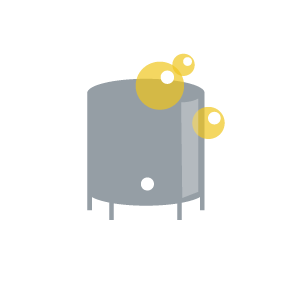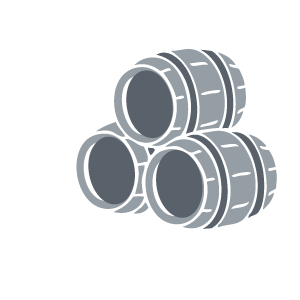D.O. Rueda
Winemaking
Winemaking

HARVEST
The key is harvesting at night, when the lower temperatures prevent the grapes from being damaged.

FERMENTATION
Fermentation is mainly carried out in stainless steel vats at a controlled temperature, and it can also take place in oak barrels.

BOTTLING
The correct colour and aroma are achieved in three months. At this time, it is bottled.

AGEING
Oak barrels are used to age the wines on lees.
The Rueda wines of old were the very first to increase in value as they were aged. Until the 18th century, most wines were sold young, leaving the port of Cádiz for international markets and especially Great Britain. Some documents from the 16th century make a distinction between “trasañejo” (very old) wines and “añejo” (more than a year old) wines, whilst new wines were called “mosto” (must).
In the late 1970s, the wines produced in Rueda were known to be flavoursome, warm, and smooth, with a touch of rusticity. The region’s luxury wine was the “Dorado”, a throwback to Spain’s Golden Age when fortified white wines were served at the Royal Court of the Catholic Kings.
The wine’s special characteristic was its “rancio” flavour and style. A Royal Decree in 1911 declared that the wine of Tierra de Medina was of special rank, “similar to the wines made in Jerez and Málaga”.
Times have since changed. Place and origin are now more important than a wine’s age and alcohol content.
“THE SKILL OF THE WINERY OWNERS AND GROWERS AND THE USE OF THE LATEST TECHNOLOGIES ARE THE TWO KEY FACTORS FOR QUALITY WINE”.
Mechanisation of the harvest means that oxidation of the musts is avoided. The vast majority of the grape-picking in Rueda is now done at night, without sunlight – the catalyst for oxidation of the musts – permitting the grapes to be delivered to the wineries at low temperatures (10-15ºC), as opposed to daytime temperatures in September of 24- 28°C. Fermentation takes place in temperature-controlled, stainless-steel vats, sometimes after passing through must-chillers or vacuum filters to clean the juice without stripping it of any of the nutrients necessary for the yeasts to start fermentation. The clean and pale juice is ready to turn into wine. After three months the wine develops a yellow colour with a youthful, green hue. It has a fresh, fruity aroma and flavour. This is the key moment for the wines to be bottled, having reached their benchmark Rueda Verdejo style – well-known and enjoyed around the world as a young, un-oaked white wine that has been harvested and vinified in rigorously hygienic conditions so that the Verdejo varietal can express its full, fruit flavour, power, and elegance.
The new Rueda era has also seen winery owners and growers from the region investing in special edition wines that are surprising and delighting consumers, demonstrating the versatility of the Verdejo variety. These developments are designed to give added value to the wines with the aim of presenting the consumer with a wide range of wines suitable for any occasion.
An example of this is barrel-fermented wines of high quality, offering new sensations, where delicious hints of toasty oak and vanilla mingle harmoniously with the fruit flavours and fresh hay notes typical of Verdejo. The structure and character inherent in Verdejo means that this varietal can stand up to the addition of an element of oak and the flavours that come from barrel fermentation and ageing, preserving all of its aromatic expression for the greater enjoyment of the consumer.
Another of these preparation methods is ageing on lees, either in tanks or in barrels. This technique results in rounder, more structured wines. When carried out in tanks, the secondary aromas are enhanced, whilst with the use of barrels, tertiary aromas are added.
In recent years, some DO Rueda wineries have installed ovoid cement tanks at their facilities, the so-called concrete eggs. Thanks to their oval shape, these structures keep the lees in suspension, adding complexity to the wine. Complexity is also demonstrated by the area’s organic wines, the result of closely monitored treatments both in the field and during the production process.





